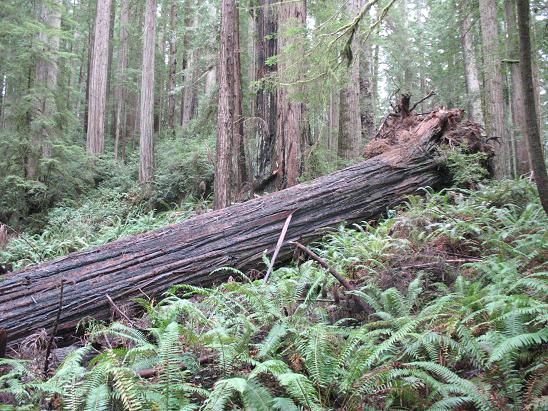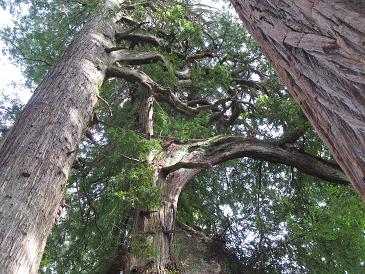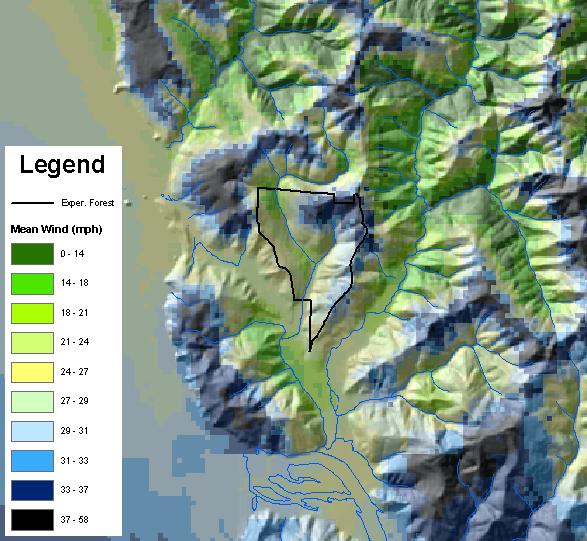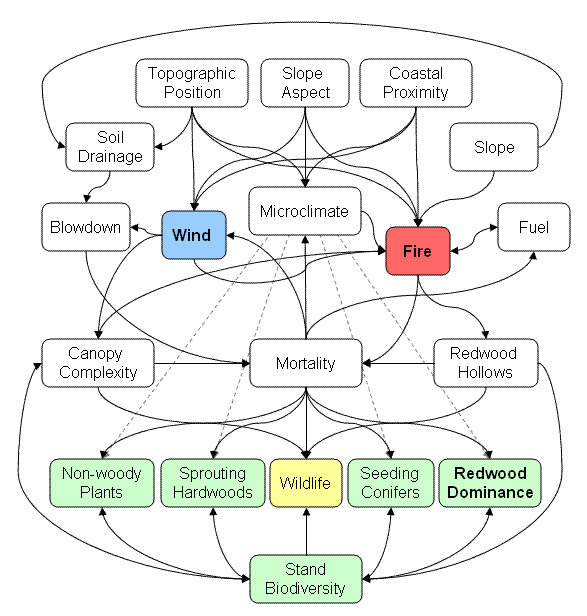|
Wind in Coast Redwood Forests
Like coastal forests to the north, California's redwood forests experience frequent winter storms that cause crown damage and tree fall. Complex crowns and canopy gaps contribute to forest diversity by creating ecological niches for a wide range of species that would otherwise be rare or absent.
Along the redwood coast, high intensity winds occur during the wettest part of the year when soils are wet and root failure is most likely. |
![A fresh blowdown in century-old second growth in the Arcata Community Forest [Credit: Steve Norman, USFS]](images/wind_acf1_sm.jpg)
|
As low pressure systems move eastward from the Pacific, gusty winds blow from the west or south. Wind speeds from such storms increase northward from San Francisco to the Canadian border. Notable forest disturbance events, such as the 1962 Columbus Day storm, had more impact in the Pacific Northwest than in the redwood forest, but blowdown can occur on an annual basis.
Uprooted trees are common in most old growth and mature second growth redwood forests, but as loggers know well, coast redwood wood is brittle and it can easily shatter when it falls. Basal resprouting can occur when boles break off near their base, but rarely when they are uprooted, and these stems normally grow quite rapidly because they feed from the main root system and have abundant sunlight in the new-formed gap.

Whether from windfall or firefall, redwood boles and upturned roots provide an elevated substrate for tree regeneration from seeds. Western hemlock preferentially establishes on fallen logs and less frequently, coast redwood may seed there as well. In Redwood National Park, redwoods clearly of seed origin that established on fallen debris have reached the canopy. Establishment on the soil surface is often difficult because of thick duff, fungi that kill seedlings, and competing vegetation. To succeed on the soil, establishment requires soil-exposing disturbance. Uprooting typically provides this near the tree's base (typically at the center of the gap), but fire can create a suitable substrate for seeding plants over an extensive area.

|
Trees and forests differ in their wind exposure and in their risk of canopy damage and blowdown. Upper slopes that face south and west receive regular severe wind stress, but certain valleys, due to their alignment with the high intensity direction of storms, lead to strong channelized winds. Certain valley bottoms may experience more damaging wind than upper slopes due to this and the increased risk of saturated soil and root failure during the rainy winter months. Such sites may also be less acclimated to chronic wind. Theoretically, there are also sites that are relatively protected from severe winds--so called wind refugia. It may be here that the tallest and oldest trees occur. |
The map at right shows the relative wind speeds expected from south and west windstorms north of the Klamath River. The Forest Service's Redwood Experimental Forest is shown at the center. Note that upper slopes do not always experience the highest winds and mid and lower slopes vary in their exposure too. While wind damage strongly depends on local conditions as well as the configuration of topography, these patterns help explain forest dynamics, species composition and wind-related risks over the long term, apart from the edge effects of land use. The only study of wind's effect in redwood took place in this Forest after the 1962 Columbus Day storm (Boe 1965). |

|
Coastal portions of the redwood range burned as frequently as they did because of human ignitions, but these same areas also experienced considerable high-intensity wind, and an open stand greatly increases fire risk. Along with the geography of ignitions, gradients of wind disturbance help us understand the reasons for high coastal fire frequency and vegetational diversity beyond high historical densities of people.
This synergy between dry season fire and wet season wind is only beginning to be understood. In some ways, wind acts as a surrogate for fire, and because of fire exclusion, wind is now the dominant disturbance in most old growth stands. But how is wind different from fire? From a landscape perspective, the places that experience heavy wind are not entirely the same as those that experienced frequent or high intensity fire. At the stand level, wind and fire effects were related and their complex interactions (below) remain poorly understood. Because of this, the long-term effects of adopting a wind dominated disturbance regime for the preservation and restoration of redwood biodiversity remains a concern.

Related Pages
Steve Norman
|
|

